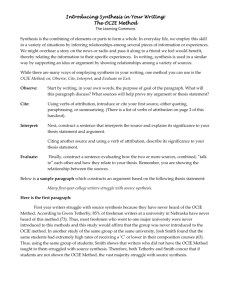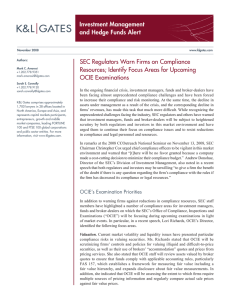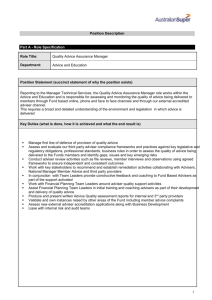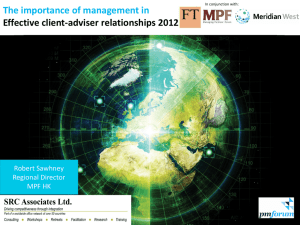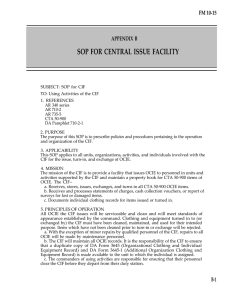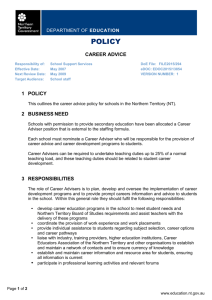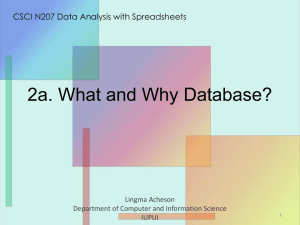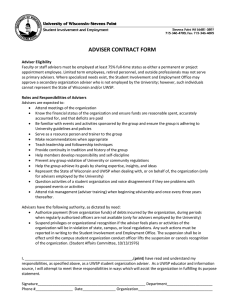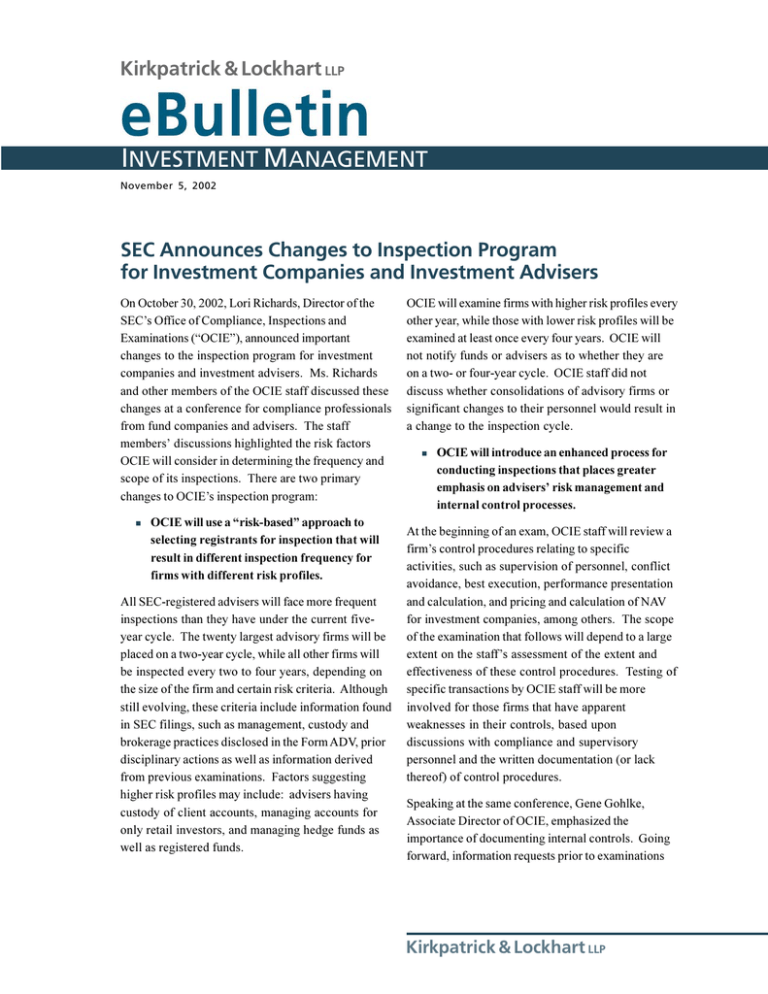
Kirkpatrick & Lockhart LLP
INVESTMENT MANAGEMENT
November 5, 2002
SEC Announces Changes to Inspection Program
for Investment Companies and Investment Advisers
On October 30, 2002, Lori Richards, Director of the
SECs Office of Compliance, Inspections and
Examinations (OCIE), announced important
changes to the inspection program for investment
companies and investment advisers. Ms. Richards
and other members of the OCIE staff discussed these
changes at a conference for compliance professionals
from fund companies and advisers. The staff
members discussions highlighted the risk factors
OCIE will consider in determining the frequency and
scope of its inspections. There are two primary
changes to OCIEs inspection program:
n
OCIE will use a risk-based approach to
selecting registrants for inspection that will
result in different inspection frequency for
firms with different risk profiles.
All SEC-registered advisers will face more frequent
inspections than they have under the current fiveyear cycle. The twenty largest advisory firms will be
placed on a two-year cycle, while all other firms will
be inspected every two to four years, depending on
the size of the firm and certain risk criteria. Although
still evolving, these criteria include information found
in SEC filings, such as management, custody and
brokerage practices disclosed in the Form ADV, prior
disciplinary actions as well as information derived
from previous examinations. Factors suggesting
higher risk profiles may include: advisers having
custody of client accounts, managing accounts for
only retail investors, and managing hedge funds as
well as registered funds.
OCIE will examine firms with higher risk profiles every
other year, while those with lower risk profiles will be
examined at least once every four years. OCIE will
not notify funds or advisers as to whether they are
on a two- or four-year cycle. OCIE staff did not
discuss whether consolidations of advisory firms or
significant changes to their personnel would result in
a change to the inspection cycle.
n
OCIE will introduce an enhanced process for
conducting inspections that places greater
emphasis on advisers risk management and
internal control processes.
At the beginning of an exam, OCIE staff will review a
firms control procedures relating to specific
activities, such as supervision of personnel, conflict
avoidance, best execution, performance presentation
and calculation, and pricing and calculation of NAV
for investment companies, among others. The scope
of the examination that follows will depend to a large
extent on the staffs assessment of the extent and
effectiveness of these control procedures. Testing of
specific transactions by OCIE staff will be more
involved for those firms that have apparent
weaknesses in their controls, based upon
discussions with compliance and supervisory
personnel and the written documentation (or lack
thereof) of control procedures.
Speaking at the same conference, Gene Gohlke,
Associate Director of OCIE, emphasized the
importance of documenting internal controls. Going
forward, information requests prior to examinations
Kirkpatrick & Lockhart LLP
INVESTMENT MANAGEMENT
will focus more on internal controls and the results
of applying those controls than they have in the
past. Mr. Gohlke also emphasized the importance of
implementing controls at two levels: 1) operational
controls that identify compliance problems on a dayby-day basis; and 2) a compliance level review of
control procedures over time that identifies patterns
that may not be evident on a daily basis. This twolevel system could identify potential problems, such
as eighth-day trading where an access person
frequently trades in his or her personal account on
the eighth day after a client trade in an attempt to
end-run the client tradesuch a potential problem
would likely not be identified by level one but should
be identified by level two.
Typical Problems Found During Inspections,
Red Flags and Best Practices
Mr. Gohlke and other members of OCIEs staff
present at the conference elaborated on the evolving
inspection program and identified typical problems
found during inspections and red flags that lead to
heightened scrutiny. The staff also identified best
practices in a number of areas. OCIE staff
highlighted the following six areas as being areas on
which the staff would focus its attention during
inspections:
PERFORMANCE ADVERTISING
In the area of performance advertising, frequent
problems found during inspections include:
n
n
n
Failure to maintain a record of the basis for
performance calculations
False and misleading statements relating to
performance, such as an unjustified claim of
being AIMR compliant or comparing
performance to an inappropriate index
Errors in calculation of performance, for
example, by not including cash in the
performance computations
n
Failure to provide current performance numbers
OCIE staff recommended that firms maintain internal
controls to assure that they properly document the
basis for performance calculations and, in the case of
composite performance, the factors considered in
selecting the accounts to include in the composite.
OCIE staff also noted that some fund complexes had
explained that it was difficult to provide the most
current performance information to publications with
long publishing deadlines. OCIE recommended that a
fund review whether performance has changed
significantly since the date on which it provided
performance to make certain that the published
performance is representative of the funds current
performance. OCIE did not elaborate, however, on
what steps could or should be taken in the event that
the published performance deviates significantly
from current performance. OCIE also recommended
that firms have procedures in place to respond to
RFPs and consultants questionnaires that request
performance information to ensure that performance
information is accurate and that prospective clients
receive appropriate disclosures relating to that
performance before becoming clients.
PRICING OF FUND ASSETS AND
NAV CALCULATION
OCIE made several recommendations relating to
pricing and net asset value calculation. First, Mr.
Gohlke suggested that firms should perform a lookback test to review the effectiveness of their fair
value procedures; this involves comparing the price
at which a security was sold and the price at which
the security was fair valued the day (or week) before
the sale. This information can be used to improve the
funds system for determining the fair value of
securities. Firms should document the results of
these comparisons, including how they handle any
individual or systemic over- or under-valuations that
are discovered.
Kirkpatrick & Lockhart LLP
2
INVESTMENT MANAGEMENT
With respect to pricing services, Mr. Gohlke
suggested that firms perform due diligence on a
pricing service, understand the process used by the
service before hiring it, and review the prices
provided by the service periodically rather than
blindly relying on those prices. Mr. Gohlke indicated
that OCIE also would review whether remedial action
was taken promptly to correct any pricing errors. In
addition, OCIE staff would review control procedures
relating to as of trades and corporate actions, such
as dividends or stock splits, including how they are
tracked and, in the event of dilution, whether the
fund is made whole.
PORTFOLIO MANAGEMENT AND
BROKERAGE PRACTICES
Typical problems or red flags identified during
inspections relating to portfolio management and
brokerage practices include:
n
n
n
n
n
Violations of client investment mandates or
investment policies set forth in prospectuses
Unfair or ad hoc trade or IPO allocation policies
or failure to disclose allocation policies to
clients
OCIE staff also recommended that advisers keep
records of the factors considered in selecting brokers
to execute trades. In evaluating brokerage
arrangements, advisers should look at not only the
transaction costs involved but also any conflicts of
interest, such as soft dollars or sales of fund shares.
In the case of sales of fund shares, Mr. Gohlke
cautioned that certain arrangements, such as
introducing/clearing arrangements or step-outs, may
be used to direct commissions to broker-dealers who
sell fund shares and, in the SEC staffs view, may fall
under Rule 12b-1. Finally, OCIE would look for crosstrading patterns over time that suggest dumping of
securitiesfor example, large funds buying
securities from small funds, with the large funds
consistently suffering losses on those securities.
BOARDS OF DIRECTORS
Frequent problems found during inspections relating
to investment company boards of directors include:
n
n
Failure to conduct a periodic and systematic
evaluation of brokerage arrangements
Use of brokerage to pay fund distribution
expenses outside of 12b-1 plans
n
Pattern of cross-trading where large funds buy
securities from small funds
n
Mr. Gohlke cautioned against inadvertent violations
of client mandates or investment limits due to poor
internal controls, as well as intentional violations in
an effort to enhance poor performance. With respect
to trade allocations, Mr. Gohlke emphasized that
allocations should be consistent with the clients
expectation of the firms allocation policy based upon
the disclosure in the advisers Form ADV. OCIE also
would review trade allocations to see if IPOs were
being disproportionately allocated to accounts with
performance-based fees.
n
n
Inadequate attendance at board meetings
(i.e., attendance at forty percent of meetings or
less), especially by independent directors
Failure to take action at in-person meetings
when required by the Investment Company Act
of 1940
Failure to take required actions on a timely
basis
Inadequate oversight of fund service providers
Inadequate descriptions of board deliberations
in minutes
Insufficient information provided to boards
when approving advisory contracts
Mr. Gohlke clarified that the SEC staff has taken the
position that videoconferencing does not meet the
in-person requirement necessary for board
approval of fund advisory contracts. In approving
advisory contracts, boards should receive
information that will enable them to understand and
Kirkpatrick & Lockhart LLP
3
INVESTMENT MANAGEMENT
evaluate whether the funds distribution network is
funded by using fund brokerage commissions or
advisory fees. Lastly, Mr. Gohlke suggested that
fund service providers give an in-person
presentation once a year to the board to assist the
directors with their oversight responsibilities.
PROVIDING INFORMATION TO
ADVISORY CLIENTS
OCIE identified the following as red flags and
frequent problems found during inspections relating
to information provided to advisory clients:
n
n
n
n
Periodic statements regarding client accounts
are sent by the adviser rather than an
independent person
Adviser has the ability to change clients
contact information at the custodian
Adviser fails to notify clients of changes to
custodial relationship, as required by custody
rule
Adviser has inadvertent custody of client
accounts
Mr. Gohlke explained that only the client should be
able to change its address with the custodian. In
addition, an independent person should send out all
client statements; otherwise, the adviser could
manipulate the statement to cover losses or
misappropriate client funds. Finally, inadvertent
custody of client accounts may result from the
adviser having a full power of attorney granting it
authority over a clients account, or where the
advisers employee is a trustee or executor of a
clients account.
ANTI-MONEY LAUNDERING (“AML”)
PROGRAMS
OCIE staff will look for four basic elements in
reviewing AML programs:
n
n
n
n
whether a specific compliance officer is
responsible for AML policies and
procedures;
whether written AML procedures are in place;
whether personnel are trained regarding AML
procedures; and
whether AML procedures are reviewed
annually.
Under the USA PATRIOT Act, financial institutions
are required to have AML programs containing each
of these elements.1
OCIE staff clarified that the specific compliance
officer responsible for a funds AML program is not
required to be a fund officer, but may be an officer of
the funds adviser. In addition, the written AML
procedures must be approved by the funds board,
and the factors considered in approving the
procedures should be documented. Mr. Gohlke
explained that if the OCIE staff finds problems with a
funds AML procedures, it will notify the funds
board rather than the adviser. Where the fund has
delegated its responsibilities for implementing parts
of its AML program to its transfer agent or another
service provider, the board should receive sufficient
information regarding the service providers
procedures.
The definition of financial institution in the USA PATRIOT Act includes investment companies and broker-dealers
but does not expressly include investment advisers. However, the Department of Treasury may ultimately interpret the
catch-all phrase included in the definition to include investment advisers.
1
Kirkpatrick & Lockhart LLP
4
INVESTMENT MANAGEMENT
Similarly, where a fund sells its shares through a
broker-dealer that has its own obligation to maintain
AML procedures, the Department of Treasury has
indicated a willingness to allow funds to rely on
broker-dealers if the fund performs some minimal
level of due diligence beyond merely asking the
broker-dealer if it has procedures.
Finally, Mr. Gohlke indicated that, where there is
suspicious activity with respect to a fund account, it
may be appropriate to close or freeze the account. He
noted that funds should have disclosure in their
prospectuses relating to the funds ability to redeem
or suspend redemptions under certain circumstances.
*
*
*
*
OCIE has implemented its new approach to
investment company and investment adviser
inspections with respect to the twenty largest firms
and has begun to focus on control procedures in its
examinations. In conclusion, Mr. Gohlke explained
that the new inspection program is designed to
provide an incentive for funds and advisers to have
in place effective controls and compliance systems.
He explained that the SECs intent in focusing on
internal controls is not to use the information
obtained in examinations to bring enforcement
actions, but rather to encourage firms to implement
internal controls that identify problems, correct them,
and seek to prevent them in the future. Overall, the
new inspection scheme puts an emphasis on having
written control procedures and clear implementation
and control of those procedures, while recognizing
that processes will vary widely from firm to firm.
DIANE E. AMBLER
202.778.9886
dambler@kl.com
ARTHUR J. BROWN
202.778.9046
abrown@kl.com
LORI L. SCHNEIDER
202.778.9305
lschneider@kl.com
Kirkpatrick & Lockhart LLP
5
INVESTMENT MANAGEMENT
Kirkpatrick & Lockhart LLP maintains one of the leading investment management practices in the United States,
with over 60 lawyers devoting all or a substantial portion of their practice to this area. According to the
April 2002 American Lawyer, K&L is a mutual funds powerhouse that represents more of the largest 25
investment company complexes and their affiliates than any other law firm.
We represent mutual funds, insurance companies, broker-dealers, investment advisers, retirement plans, banks
and trust companies, private funds, offshore funds and other financial institutions. We also regularly represent
mutual fund distributors, independent directors of investment companies, retirement plans and service
providers to the investment management industry. In addition, we frequently serve as outside counsel to
industry associations on a variety of projects, including legislative and policy matters.
We work with clients in connection with the full range of investment company industry products and activities,
including all types of open-end and closed-end investment companies, funds of hedge funds, variable insurance
products, private and offshore investment funds and unit investment trusts. Our practice involves all aspects of
the investment company business: from organizing and registering open-end and closed-end funds, both as
series and individual portfolios, to providing ongoing advice and representation to the funds and their advisers,
directors and distributors.
We invite you to contact one of the members of our investment management practice, listed below, for
additional assistance. You may also visit our website at www.kl.com for more information, or send general
inquiries via email to investmentmanagement@kl.com.
BOSTON
Michael S. Caccese
Philip J. Fina
Mark P. Goshko
WASHINGTON
(617) 2613133 mcaccese@kl.com
(617) 2613156 pfina@kl.com
(617) 2613163 mgoshko@kl.com
Clifford J. Alexander
Diane E. Ambler
Catherine S. Bardsley
Arthur J. Brown
LOS ANGELES
Arthur C. Delibert
William P. Wade
(310) 5525071 wwade@kl.com
Robert C. Hacker
Benjamin J. Haskin
NEW YORK
Kathy Kresch Ingber
Beth R. Kramer
(212) 5364024 bkramer@kl.com
Rebecca H. Laird
Richard D. Marshall
(212) 5363941 rmarshall@kl.com
Thomas
M. Leahey
Robert M. McLaughlin (212) 5363924 rmclaughlin@kl.com
Cary
J.
Meer
Loren Schechter
(212) 5364008 lschechter@kl.com
R. Charles Miller
SAN FRANCISCO
Dean E. Miller
Eilleen M. Clavere
(415) 2491047 eclavere@kl.com
R. Darrell Mounts
David Mishel
(415) 2491015 dmishel@kl.com
C. Dirk Peterson
Richard M. Phillips
(415) 2491010 rphillips@kl.com
Alan C. Porter
Theodore L. Press
Robert H. Rosenblum
William A. Schmidt
Lynn A. Schweinfurth
Donald W. Smith
Robert A. Wittie
Robert J. Zutz
(202) 7789068
(202) 7789886
(202) 7789289
(202) 7789046
(202) 7789042
(202) 7789016
(202) 7789369
(202) 7789015
(202) 7789038
(202) 7789082
(202) 7789107
(202) 7789372
(202) 7789371
(202) 7789298
(202) 7789324
(202) 7789186
(202) 7789025
(202) 7789464
(202) 7789373
(202) 7789876
(202) 7789079
(202) 7789066
(202) 7789059
calexander@kl.com
dambler@kl.com
cbardsley@kl.com
abrown@kl.com
adelibert@kl.com
rhacker@kl.com
bhaskin@kl.com
kingber@kl.com
rlaird@kl.com
tleahey@kl.com
cmeer@kl.com
rmiller@kl.com
dmiller@kl.com
rmounts@kl.com
cpeterson@kl.com
aporter@kl.com
tpress@kl.com
rrosenblum@kl.com
wschmidt@kl.com
lschweinfurth@kl.com
dsmith@kl.com
rwittie@kl.com
rzutz@kl.com
®
Kirkpatrick & Lockhart LLP
Challenge us.®
www.kl.com
BOSTON
n
DALLAS
n
HARRISBURG
n
LOS ANGELES
n
MIAMI
n
NEWARK
n
NEW YORK
n
PITTSBURGH
n
SAN FRANCISCO
n
WASHINGTON
.........................................................................................................................................................
This publication/newsletter is for informational purposes and does not contain or convey legal advice. The information herein
should not be used or relied upon in regard to any particular facts or circumstances without first consulting a lawyer.
© 2002 KIRKPATRICK & LOCKHART LLP. ALL RIGHTS RESERVED.

